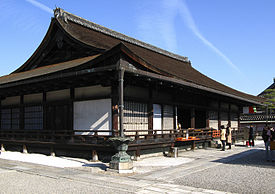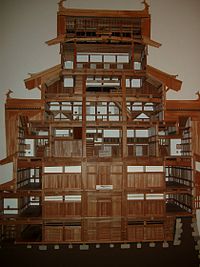- Dō (architecture)
-
Dō (堂) is a Japanese word for building. It is very often used in Japanese Buddhism as a suffix in the name of some of the many buildings that can be part of a Japanese temple compound. (Other endings, for example -den as in butsuden, exist.) The prefix can be the name of a deity associated with it (e.g. Yakushi-dō, a name customarily translated as "Yakushi Hall") or express the building's function within the temple's compound (e.g. hon-dō, or main hall).[note 1]
Some words ending in -dō are Butsu-dō, hō-dō, hon-dō, jiki-dō, kaisan-dō, kō-dō, kon-dō, kyō-dō, mandara-dō, miei-dō, mi-dō, sō-dō, Yakushi-dō and zen-dō. With some exceptions, for example the words hondō, hokke-dō and kon-dō, these terms do not indicate any particular structure.
The suffix is used sometimes also in a lay context, as for example in the word shokudō (食堂 lit. food building, meaning restaurant or cafeteria).
A dō's size is measured in ken, where a ken is the interval between two pillars of a traditional-style building. A kon-dō for example is a 9x7 ken.[1] The word is usually translated in English as "bay" and is better understood as an indication of proportions than as a unit of measurement.
Types
- Amida-dō (阿弥陀堂) - a building that enshrines a statue of Amida.[2]
- daishi-dō (大師堂) - lit. "great master hall". A building dedicated to Kōbō Daishi (Shingon) or Dengyō Daishi (Tendai).[2]
- hattō* (法堂) - lit. Dharma hall". A building dedicated to lectures by the chief priest on Buddhism's scriptures (the hō).[3]
- hō-dō (法堂) - see hattō.
- hokke-dō* (法華堂) - lit. "Lotus Sūtra hall". In Tendai Buddhism, a hall whose layout allows walking around a statue for meditation.[2] The purpose of walking is to concentrate on the Lotus Sũtra and seek the ultimate truth.[2]
- hon-dō* (本堂) - lit. "main hall", it is the building that houses the most important statues and objects of cult.[2] The term is thought to have evolved to avoid the term kon-dō used by six Nara sects (the Nanto Rokushū)[2] for their main halls. Structurally similar, but its inner less strictly defined.
- jiki-dō* (食堂) - a monastery's refectory.[2]
- kaisan-dō (開山堂) - founder's hall, usually at a Zen temple. Building enshrining a statue, portrait or memorial tablet of the founder of either the temple or the sect it belongs to. Jōdo sect temples often call it miei-dō.[2]
- kō-dō* (講堂) - lecture hall of a non-Zen garan.[3]
- kon-dō* (金堂) - lit. "golden hall", it is the main hall of a garan, housing the main object of worship.[2] Unlike a butsuden, it is a true two-story building (although the second story may sometimes be missing) which measures 9x7 bays.[2]
- kyō-dō (経堂) - see kyōzō.
- kyōzō (経蔵) - lit. "scriptures deposit". Repository of sūtras and books about the temple's history.[2] Also called kyō–dō.
- mandara-dō (曼荼羅堂) - lit. "hall of mandalas", but the name is presently used only for Taimadera's Main Hall in Nara.[2]
- miei-dō* (御影堂) - lit. "image hall". Building housing an image of the temple's founder, equivalent to a Zen sect's kaisan-dō.[2]
- mi-dō (御堂) - a generic honorific term for a building which enshrines a sacred statue.[2]
- rokkaku-dō (六角堂) - a hexagonal temple building. An example of this type of structure gives its nickname to Kyoto's Chōhō-ji, better known as Rokkaku-dō.
- shaka-dō (釈迦堂) - lit. Shakyamuni hall. A building enshrining a statue of Buddha.[2]
- sō-dō* (僧堂) - lit. "monk hall". A building dedicated to the practice of zazen.[3] It used to be dedicated to all kinds of activities, from eating to sleeping, centered on zazen.
- soshi-dō (祖師堂) - lit. "patriarchs hall". A building dedicated to the soshi, important teachers and priests.[2]
- Yakushi-dō* (薬師堂) - a building that enshrines a statue of Yakushi Nyorai.[2]
- zen-dō* (禅堂) - lit. "hall of Zen".[2] The building where monks practice zazen, and one of the main structures of a Zen garan.[2]
Notes
- ^ Hall names are capitalized only when they refer to specific examples (e.g. XX-ji's Main Hall) or include proper names of deities (e.g. Yakushi-dō).
References
Elements of Japanese architecture Styles Buddhist · Buke · Daibutsuyō · Gassho · Giyōfū · Hachiman · Hirairi · Hiyoshi (also called Hie) · Irimoya · Ishi-no-ma · Kasuga · Kibitsu · Nagare · Ōbaku Zen · Setchūyō · Shinden · Shinmei · Shinto · Shoin · Sukiya · Sumiyoshi · Taisha · Wayō · ZenshūyōA model of Himeji Castle
Building types Roof styles Structural Burdock piling · Chigi · Disordered piling · Engawa · Fusuma · Hisashi · Irimoya-zukuri · Irori · Jinmaku · Katōmado · Katsuogi · Kuruwa · Mokoshi · Moya · Nakazonae · Namako wall · Nightingale floor · Onigawara · Ranma · Shōji (see also washi) · Sōrin · Tamagaki · Tatami · Tokonoma · Tokyō · Tsumairi · ShibiGates and approaches Rooms Furnishings Outdoor objects Measurements Groups See also Buddhist temples in Japan Japanese Buddhist architecture Architectonic elements Mon (gates) Buildings Chinjusha · chōzuya/temizuya · -dō · main hall (kon-dō, hon-dō, butsuden) · kuri · kyōzō or kyō-dō · shoinTō or Buttō (pagodas) Styles Others A-un · kenSchools and objects of worship Major schools Zen schools Nanto rokushū Objects of worship Amida Nyōrai · Benzaiten · Dainichi Nyorai · Jizō · Kannon · Marishi-ten · Shaka Nyorai · Shitennō (Four Kings) · Twelve Heavenly Generals (Jūni Shinshō) · Yakushi NyoraiOther elements Implements kei (ritual gong) · mokugyōOthers bussokuseki · butsudan · Glossary of Japanese Buddhism · Japanese Buddhist pantheon · jingū-ji · miyadera · saisenbakoCategories:- Japanese architectural features
- Japanese architecture
- Buddhism in Japan
- Buddhist art and culture
Wikimedia Foundation. 2010.


